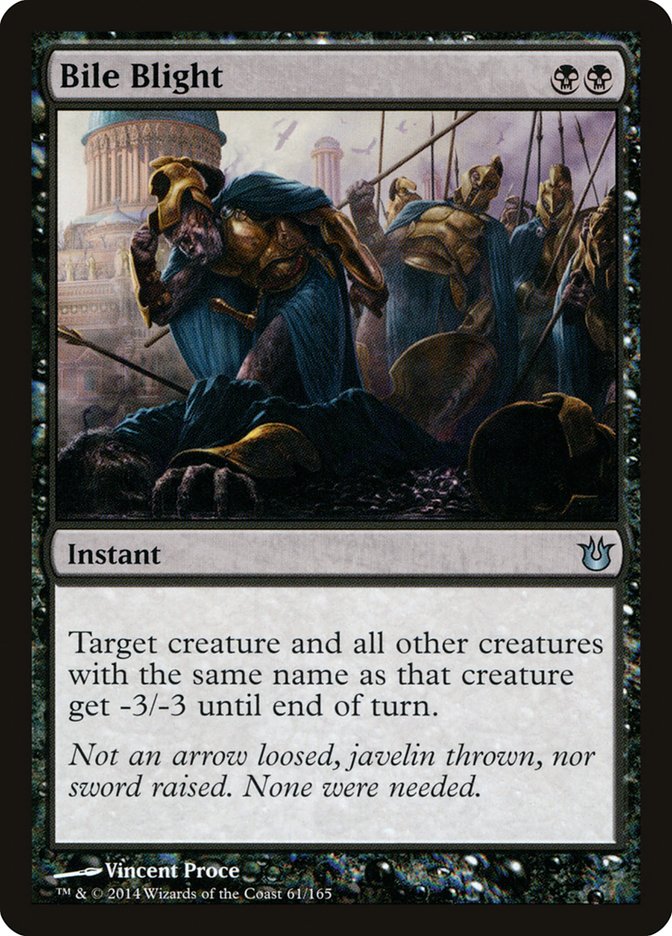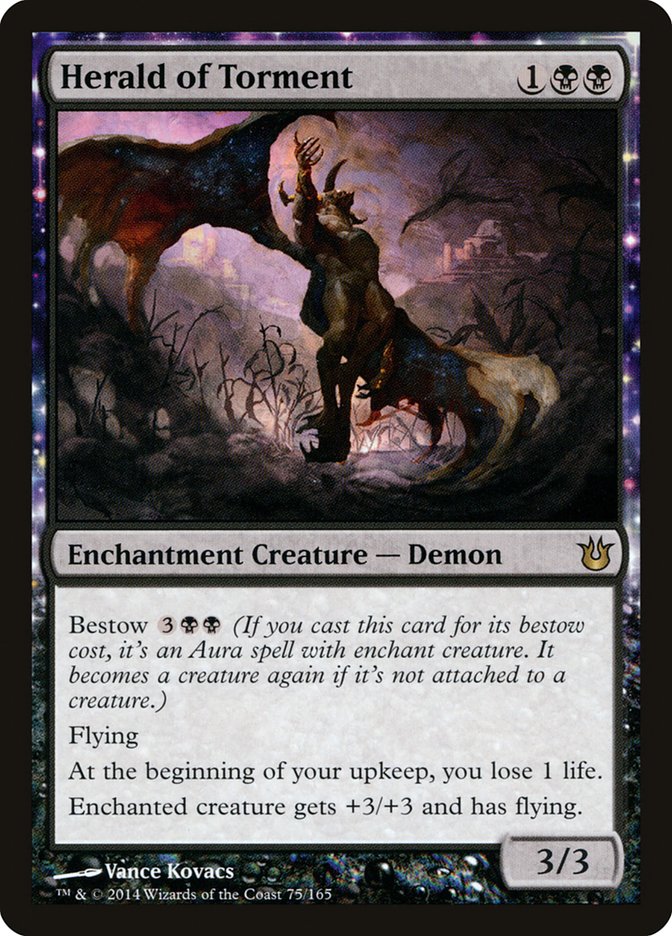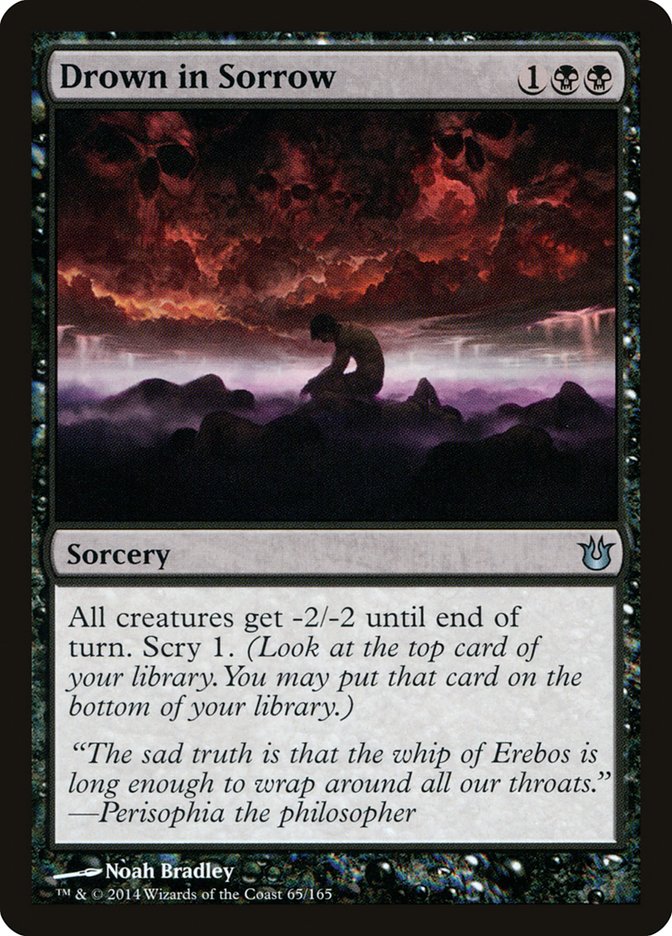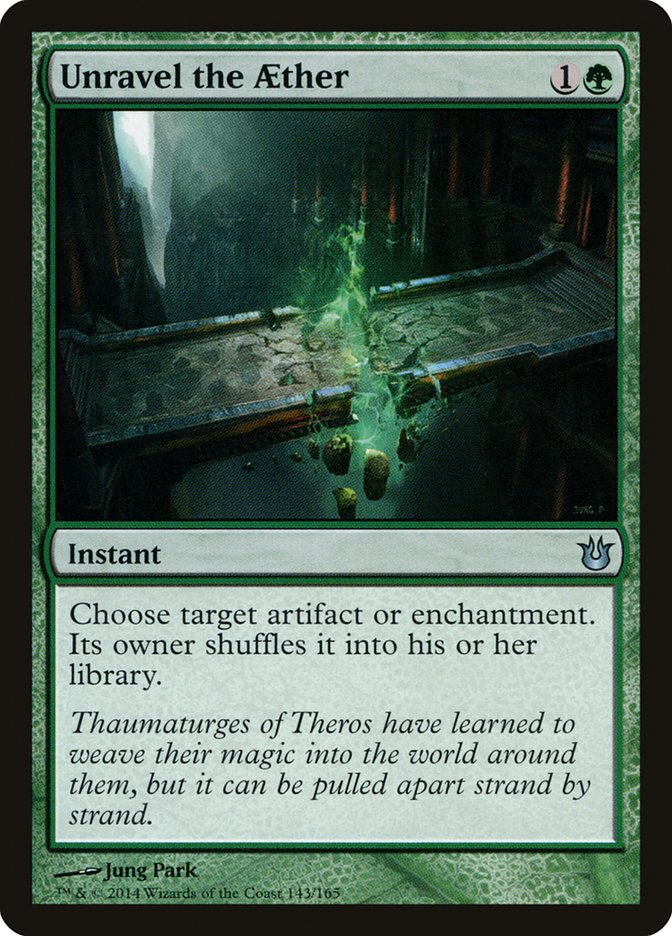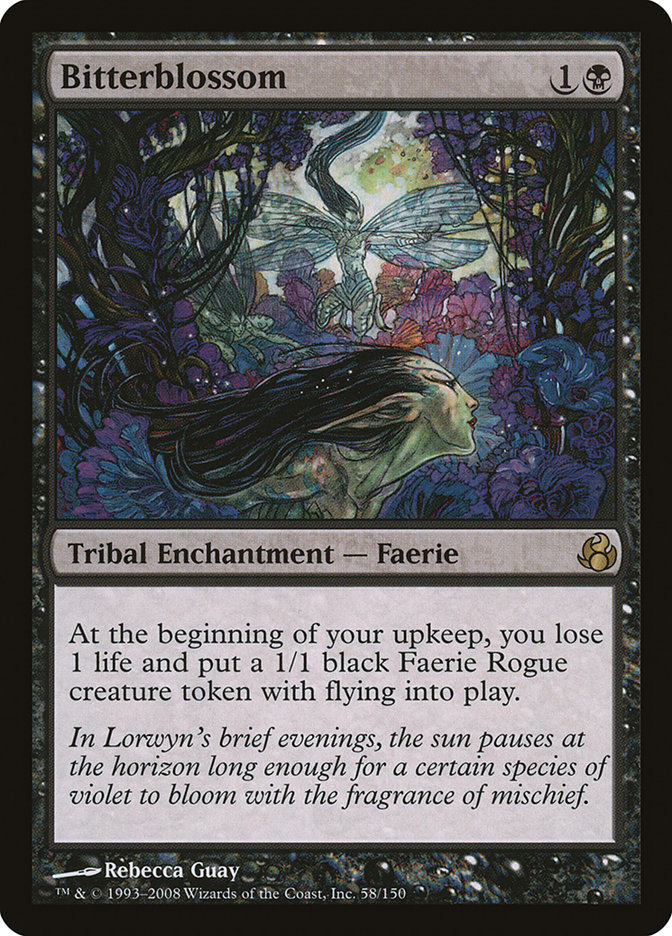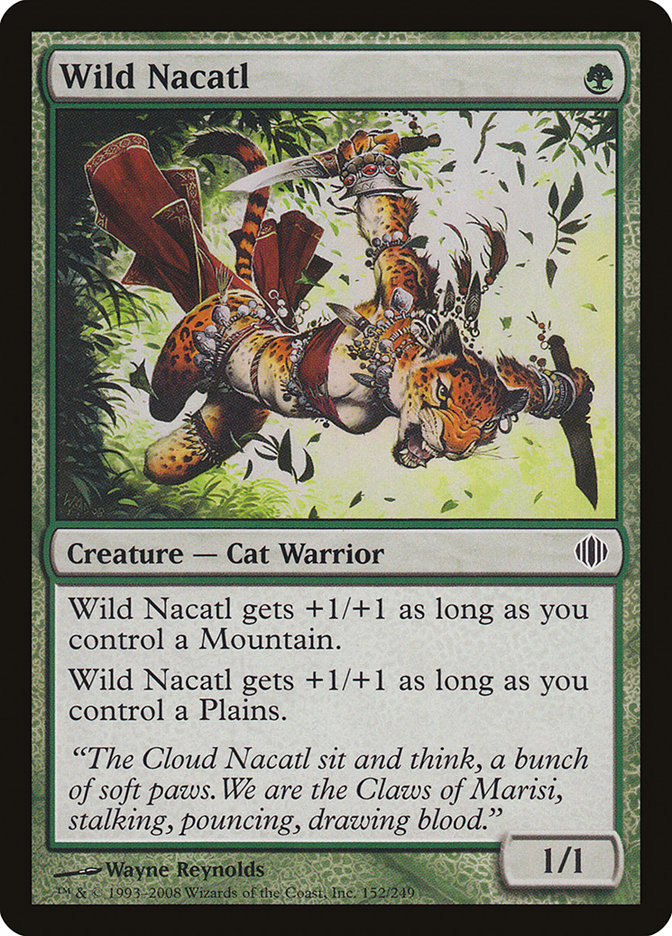Sometimes it can be hard to write on the same website as Patrick Chapin.
It’s not that I don’t mind the competition; some of my favorite articles that I’ve ever written came out of my desire to rebut someone, usually Mike Flores but certainly other people from time to time. I still love a good rebuttal (assuming it is necessary). It can be very hard to do an article with brews the week that Patrick Chapin does an article on brews. Suffice it to say, you will get buried. Chapin hit about 8,000 words in one of his two articles this week, and I thought to myself, “You know, let’s move elsewhere.”
I asked one of my friends what I should cover, and he immediately brought up Grand Prix Louisville. I had a very exciting weekend in Louisville, where I debuted an awesome BUG deck to Top 64. I was really proud of the deck and thought it did some interesting and innovative things. Here’s what I played in Louisville:
Creatures (15)
Planeswalkers (2)
Lands (25)
Spells (18)
Sideboard

There was a lot I was proud of with this deck. Following the Pro Tour, people hadn’t yet gotten the memo that Nightveil Specter was incredible as a possible card to play over Lifebane Zombie. The mana in this deck pushed hard to be able to not only play black and green reliably in game 1 but also have room for blue in the board.
In many ways, though, this weekend reminded me of the weekend of the first Grand Prix, Grand Prix Toronto, over fifteen years ago. I won my first PTQ at an event in Wisconsin with some innovations on my friend Ronny Serio’s Ophidian deck that rocked the world a few weeks earlier. Brian Kibler, on the other hand, took down the Grand Prix with essentially the same deck but on a much higher stage.
So it was in Louisville. I had a good finish to be sure, and if not for some heartbreaking bad beats, I may well have done better. On the other hand, Brian Braun-Duin led the way for the SCG crew at that Grand Prix with a streamlined Mono-Black Devotion deck that started its evolution to take over the metagame. While I actually am pretty confidant that back in the ’90s my build of Ophidian ("Tempo Blue" I called it) was better than Kibler’s, in this case I can tell that my deck for Louisville was not as good as this:
One thing that might be a bit strange about this to our more "enlightened" eyes is the lack of a full set of Pack Rats. That would come eventually, of course, but the real shift in this deck to my mind is the commitment to Nightveil Specter over Lifebane Zombie, just like in my deck. This was a big technology shift, and it matters a lot in how this deck performs. Interestingly, though, with the printing of a single card, things can change:
With this card in the books, Patrick Chapin has already advocated the reduction of Pack Rats in Mono-Black Devotion. A big part of the reason is that now Bile Blight is in print Pack Rat loses a lot of power in the mirror, requiring four Pack Rats to keep your Rats all alive. That is a hard thing to ask for.
Aside from punishing Pack Rat, outside of the mirror Bile Blight is a great weapon against aggressive decks as well. One of the huge problems with finding a removal suite for these decks before was finding something that could be counted on to kill enough of the right cards because the various limitations of each removal spell could be really difficult. Now, though, a great answer exists in Bile Blight, filling much the same role Abrupt Decay did in my BUG deck, albeit also able to kill Mutavault (which Decay cannot).
I did a lot of thinking about other cards from Born of the Gods that might merit maindeck inclusion in my BUG list. Kiora, the Crashing Wave was one of the cards that I definitely thought a lot about before discarding, largely because I wasn’t planning on running mana acceleration and such a low loyalty seemed not in keeping with a four-drop. Pain Seer also seemed worth considering, but this deck didn’t feel aggressive enough for that to be correct. Sanguimancy was another card that I considered, albeit reservedly (five mana is a lot).
The biggest draws other than Abrupt Decay were these cards:
Of them the Courser was the easiest to reject, primarily because the green commitment was just too high. Herald of Torment was much more difficult but ultimately something to reject because the deck I was thinking about simply wasn’t that aggressive. I think a true Herald of Torment deck definitely exists, but I’m willing to bet it is at most only two colors. Drown in Sorrow and Unravel the Aether were worth consideration but ultimately felt more like sideboard cards. When all was said and done, I had come to this:
Creatures (14)
Planeswalkers (1)
Lands (26)
Spells (19)

The most glaring elements of this deck are a smaller number of Thoughtseizes and zero Underworld Connections.
I’m going to say that I agree with Owen Turtenwald: I don’t like Underworld Connections.
What it really boils down to is that I don’t think it is effective against nearly any deck other than the mirror. Against the most aggressive decks, it is a complete liability. Against decks like Mono-Blue Devotion, it is very easy to get run over. In fact, Owen himself recommends boarding it out against basically every deck besides the mirror and U/W Control. And frankly, in the U/W Control matchup, I don’t even think that Underworld Connections is that big of a deal.
I’ve played that matchup from the U/W Control side of things a million times, and unless the U/W Control deck stumbles on mana or gets beaten down very quickly from the get go, Underworld Connections just doesn’t keep up. In the place of Underworld Connections, I have other forms of card advantage, and I also run Abrupt Decay, which can save a scary permanent from Detention Sphere, help win the Nightveil Specter fight, or kill an early permanent.
Very few Thoughtseizes is bound to be more controversial, but in this I look to most of the Esper Control lists, which while they had access to four Thoughtseizes often only ran one or two copies of the card. Once Pack Rat had managed to be an automatic four-of, it made a lot more sense to have Thoughtseize as a means to protect the Rat or in the mirror to stop the rat. That fight is not nearly so difficult now that you have Bile Blight. In addition, this deck runs Gaze of Granite, so dealing with problematic cards that get into play is not nearly so difficult.
I feel like the original version of this deck was definitely way ahead of the curve, but after Louisville it certainly fell behind the curve. With the advent of the new set, many of the conditions that I think made Mono-Black Devotion simply the way to go have evaporated. Mono-Black Devotion was simply the best Pack Rat deck, and if you were going to be a Pack Rat deck, it just ended up being that there really was no substitute for playing the deck Owen Turtenwald took to victory at the SCG Standard Open in Indianapolis.
Bile Blight changes the fight such that Pack Rat is still certainly a weapon but is not simply the be all and end all as it had been. In addition, access to powerful sideboard cards outside of a single color really help push this deck up in my estimation of it. I expect to continue to tinker with this deck and think it has all of the tools necessary to be a contender in Standard.
Outside of Standard brewing, though, I’ve been trying out some new things in Modern as well (if by "new" you mean "old").
I’ve done a lot of Modern brewing in the last few days since the banned and restricted list was announced. While the loss of Deathrite Shaman is huge for the format ("Unnecessary," says my boss Bob Maher; "Agreed," says my co-worker Brian Kowal), the unrestriction of these two bad boys should shake the format as well:
While Nacatl opened a whole other can of worms, Bitterblossom brought back some memories. One of the things I really wanted to do was revisit my Lorwyn Block experiment covered in my article “A Case Study In Playing The Wrong Deck” called Sisters Grimm, a “four-color mono-black” deck inspired by Jamie Wakefield’s Brothers Grimm from the mid-’90s. It wasn’t good enough for Block, but it did end up being a deck that I toyed with in Extended to some minor success just before Extended was dropped as a format.
Bitterblossom is an incredibly exciting card and always seems to manage to do far more than one might have expected. Even cards that can get a player made fun of (some people made fun of Zvi Mowshowitz when he played Spellstutter Sprite before Bitterblossom) can become potent when you have an infinite (okay, as bound by time and life) supply of Faeries waiting in the wings ready to come out one at a time.
My first attempt that actually seemed to coalesce in a meaningful way is essentially a Rock deck. We may have lost Deathrite Shaman, but there is still a lot to like about black and green working together.
Creatures (14)
Planeswalkers (3)
Lands (25)
Spells (18)

This is a pretty straightforward Pox-Rock deck that tries to make sure that it takes advantage of the limited resources that are available in "Pox" world. There are a couple of odd flourishes that are semi-peculiar to me that I feel bear explaining.
If you’ve never played with Sword of Light and Shadow in a deck like this, I highly recommend it. This is a deck built for attrition, and it runs a ton of creatures that are very powerful. Just getting a creature back once can be a huge deal. Particularly in a world where Bitterblossom might be seeing heavy play, protection from black is a big deal. In a world where Nacatl might be seeing playing, gaining three life is as well.
The mana base is designed to maximize greediness without going overboard. This includes five lands that can’t do a thing on turn 1 and four Twilight Mires and three Urborg, Tomb of Yawgmoths. The Mires and Urborgs are there help you cast Smallpox and be able to have Treetop Village in the same deck. Urborg is particularly safe in this regard because you have both Smallpox and Liliana to minimize the cost of extraneous copies. The Leechridden Swamp is something I’ve toyed with for years. I was convinced about its efficacy in my Top 64 deck from Grand Prix Chicago, where I ran a single copy, but I shifted on and off to two copies thereafter. In a deck with fetch lands and Bitterblossom, it is even more effective, so I highly recommend it.
I haven’t yet played the deck against Birthing Pod, so it’s possible that more cards are needed to fight that matchup. Right now a combination of Grafdigger’s Cage, copious discard, and removal are a part of the path. It could be that the deck needs more than that though.
I’m still working on this list, but right now I’m quite pleased with how it’s doing a full two days into working on decks in Modern. Granted, this is likely not going to be the best deck by the end of February, but Magic is very much about building on prior technology—as I talked about above, we didn’t even run four Pack Rats in Mono-Black Devotion until after Louisville was in the rearview mirror after all.
This weekend I’m driving down to Nashville for the SCG Open Series. I have a bunch of friends down there who love three things: Magic, music, and good drinks. Hopefully, all three will be had.
I’m actually still trying to figure out what I’m going to play in Legacy. Will you be in Nashville? What would you play if you were going? And does Spirit of the Labyrinth have a role in Death and Taxes? Right now I don’t think it belongs in the main, but what do you think?

